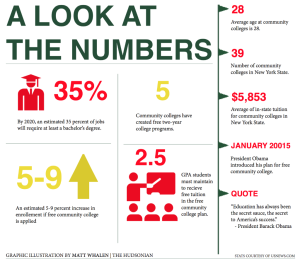Campus sentiment split over tuition debate
Tyler McNeil
Managing Editor
“Providing two years of community college at no cost for every responsible student is one of the best ways to do that, and I’m going to keep fighting to get that started this year,” said President Obama about reducing student loan payments in the State of the Union address two weeks ago.
Alex Hobbs, an early childhood education student who hopes to transfer to Saint Rose by the fall, believes free tuition at Hudson Valley would’ve given her an easier start before putting on student loan debt next semester.
“Free tuition should be [for] all community colleges just to get people on their feet to at least get an associates degree,” she said. The average graduate debt for Saint Rose in 2013 was over $34,000 according to the Institute for College Access & Success.
Nicolaus Lagrange, ECM student, fears the repercussions of free community college reaching his home. He believes that higher taxes would result from funding free community college and would have negative consequences for his family’s dairy farm in Selkirk. “We don’t make much money as it is,” he said. “We’re already paying land taxes, school taxes and a bunch of other taxes.”
Since last year, the idea of free community college has ignited controversy from debate stages to the House of Representatives chamber. Obama first introduced a proposal last January that included making the first two years of community college tuition-free. Since the proposal, presidential candidate Hillary Clinton has also latched on to a free community college plan in her platform.
Abby Westfall, individual studies student, currently works two jobs to pay off half of her tuition. “I know it would suck because taxes would increase, but in a sense it would work out towards my education,” said Westfall about free community college.
Obama’s plan included a system of cost-sharing for free community college (75 percent federal spending, 25 percent state funding). Pell grants would help pay for room and board, transportation, and other costs associated with attending college for students in extreme poverty.
“Community college is cheap as it is,” said Max Thompson, theatre arts major. Hudson Valley’s tuition cost is currently $2,050 per year for full-time, in-state students. The average cost of tuition for full-time, in-state residents across SUNY community colleges in the 2015-16 academic year is $2,105.
Governor Andrew Cuomo met with the White House last September to discuss free community college in New York State. “I think it takes awhile for New York [State] to get on top of things,” said Justin Hunt, business student.
Currently, only Oregon and Tennessee have tuition-free community college systems.
Hunt mentioned support for presidential candidate Bernie Sanders’s platform to make all public colleges tuition-free. According to a Hudsonian election poll last month, 46 percent of student support Sanders in the 2016 presidential race.
Sanders’s free tuition plan includes a 0.5 percent fee on stock trades, a 0.1 percent fee on bonds and a 0.005 percent fee on derivatives which aims to pay up to $750 billion over a decade for college tuition.
“I served in the military. There’s no such thing as a free education,” said Darrin Smith, ECM student, who was able to pay for his tuition through the GI Bill. Similar to Martin O’Malley and Hillary Clinton, he hopes to increase federal financial aid, but opposes free tuition.
In November, Clinton responded to Sanders’s plan, arguing, “I don’t think taxpayers should be paying to send Donald Trump’s kids to college.” Although Kevin Terleckey, liberal arts student, plans to go UAlbany next semester, he believes that free tuition for public institutions would be unfair to all students. “For me, it would help because I’ve only had $40 in financial aid this semester, but I feel like it’s unfair to everybody,” he said.
The only service at Hudson Valley that decreases the price of tuition, regardless of a student’s ability to qualify for financial aid is the Second Chance Scholarship Program. Every year, the scholarship is awarded to students who have overcome personal obstacles in order to pursue an education, regardless of their financial situation.
Under the program, students can receive as much as $1,500 based on credits and academic performance. “If there was an element of that in this free tuition idea being kicked around, I really think that might be a concept worth exploring,” said President Drew Matonak, about tuition-free community college.

